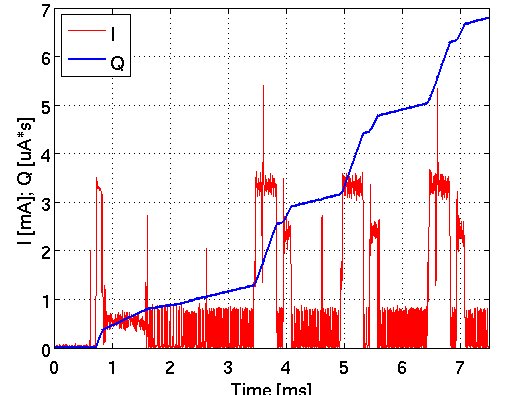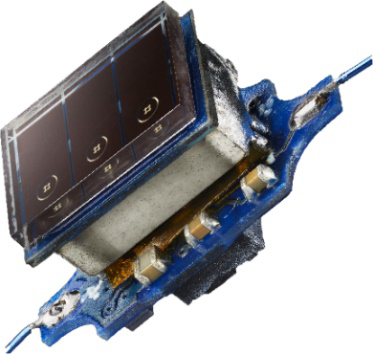Sponsored by CSEMOct 23 2020
This multidisciplinary project looks to demonstrate a miniaturized energy-autonomous wireless sensor node that is powered with a solid-state battery and a 3-segment PV-cell. It can interact with mobile phones, tablets and the cloud while harvesting its own energy, despite its 5 x 3.4 x 3 mm3 size.
Digitalization, IoT, and industry 4.0 are three fashionable keywords which all share a common requirement. This requirement is to attain seamless data transfer between a network of distributed intelligence, sensors and the cloud with its unlimited computing resources.
Bus interconnected sensors can be deployed quite easily while power-plugged, but wiring is voluminous, costly, lengthy and heavy (meaningful for cars and planes) and it is quite difficult to deploy a posteriori, preventing flexibility and reconfigurability.
Even though, over the last thirty years wireless data transfer has gradually eliminated the data routing wire requirements (WiFi, mobile phones, Bluetooth/BLE), one issue remains: how to cut the power plug, which is the last wire, without being trapped into the battery replacement/recharge maintenance hurdle.
Obviously, part of the answer is energy harvesting, but energy usage optimization through proper architecting and management is crucial. Among the different energy sources widely available, for many use-cases harvesting sunlight or even indoor lighting with compact photovoltaic diodes already fulfills the powering needs.
Considering the solar-powered, hand-held calculators of the late seventies, but also the huge performance enhancement due to CMOS scaling, could a miniaturized wireless sensor node capable of 365 d / 24 h monitoring and seamless interactions with the cloud via mobile phones and tablets be designed?

Figure 1. Current profile of a BLE advertisement beacon with RSL10. Image Credit: CSEM
In order to build an energy autonomous wireless sensor the key requirements can be summarized as follows:
- Use a ULP timing source to maintain network synchronization over idle periods which is precise enough to organize timely periodic wake-ups to carry out correlated sampling or exchange data wirelessly among spatially distributed sensor nodes
- Utilize smart ULP sensors which enable context-level hierarchical or threshold-triggered sensing autonomously
- Carry out edge processing, for example, compute at node level to extract higher-level information and minimize the energy cost of transmitting excess data
- Secure cloud access while, either via a dedicated local hub gateway, or better still, taking advantage of an already widely deployed, standardized, communication infrastructure, dissipating as little energy as possible locally.
- Manage and optimize the energy harvesting, storage and distribution in order to guarantee the optimum sensing performance and quality of service at any time.
A modern IoT system-on-chip (SoC) like On Semiconductor's RSL10, which is one of the lowest power circuits available on the market that relies on CSEM BLE IP can be used to satisfy requirements 1, 3, 4 and 5.
The current consumption of the SoC while transmitting BLE beacons consecutively in the three advertisement channels after the system resumes following a timer interrupt is shown in Figure 1. In timekeeping mode, a quiescent current consumption of 250 nA including leakage is attained.
The charges which are drawn from a 3 V supply reaches 7 µA·s per beacon, 55% of which is utilized for the 3 x 35 bytes transmission, 28% for the MCU to execute the IRQ code and 17% to potentially acknowledge reception should a master try to bond with the device.
The MCU begins the radio XTAL within the first 3 ms, it also performs a battery voltage measurement using the on-chip ADC, restores the system clock, updates the data to be transmitted and turns on the different power management blocks before triggering the modem and returning idle.
One gets sub-µA current with 1 beacon / 10 s. The BMA400, a novel 3-axis accelerometer developed by Bosch, was chosen as a smart sensor illustrative of 2. It has a current consumption of 150 nA, 850 nA, 4 µA, 15 µA respectively in off, motion activation, step analysis and full accelerometer modes.
This sensor incorporates low-power digital accelerators that can autonomously carry out orientation detection (tilt), (in)activity detection and recognition, step counting and tap/double tap detection.
Both data transfer between the sensor / system MCU and the computational load are reduced massively, as such high-level context signals are all mapped to dedicated IRQs, which results in substantial power savings.

Figure 2. Photograph of the miniature wireless sensor node. Image Credit: CSEM
Figure 2 shows the resulting miniature sensor node. The mote measures 5 x 3.4 x 3 mm3 excluding the antenna, while including a 3-segments PV-cell forming the power pack and a 200 µA·h battery.
Despite foggy days 50 µA·h could be harvested daily on average, even when it was placed on a west facing window in winter time. This is sufficient power the complete sensor node and monitor window tilt, opening/closing and carry out glass break detection.
Other applications like art or asset surveillance or even lapel pin or earrings remote controls using (double) tap functions can be imagined. Field tests are currently being carried out, paving the way towards a cloud of ubiquitous motes that one may merely drop to the cloud.
Acknowledgments
Produced from materials originally authored by D. Ruffieux, J. Bailat, P.-A. Beuchat, S. Biselli, J. Brossard, M. Dadras, C. Denizot, D. Domine, M. Fretz, R. Jose James, Y. Liechti, Y. Marozau, P. Nussbaum, P. Stadelmann and S. Zabihzadeh, L. Zahnd from CSEM.

This information has been sourced, reviewed and adapted from materials provided by CSEM.
For more information on this source, please visit CSEM.